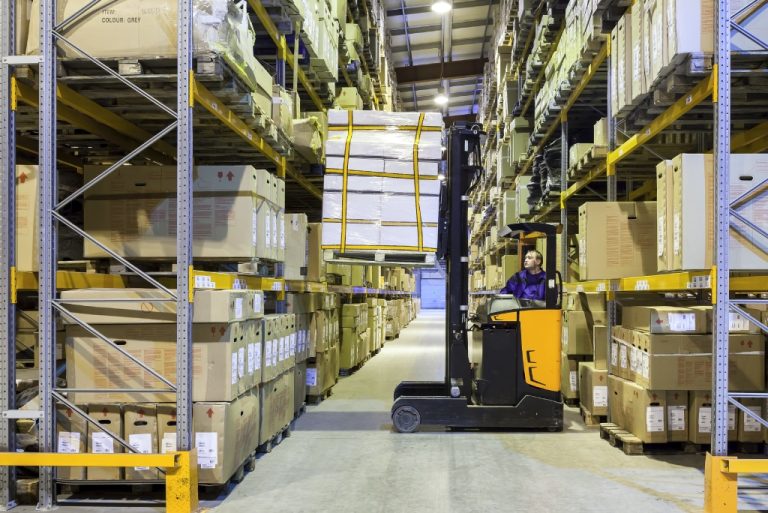Selecting the right material handling equipment is essential for optimizing workflow, reducing labor costs, and improving workplace safety. Whether you are thinking about investing in new or used warehouse equipment, this guide will explain the different types of equipment, best practices for how to select material handling equipment, and where you can find the best options online.
Common Types of Material Handling Equipment
Material handling equipment can be classified into four major categories:
- Storage and handling equipment: Designed for organizing and storing inventory efficiently.
- Industrial trucks: Used for transporting materials within a facility.
- Bulk material handling equipment: Facilitates the movement of bulk goods.
- Automated and smart systems: Incorporates technology for efficiency and accuracy.
Let’s look at each of these components as they come together to create a modern warehouse.
Storage and Handling Equipment
You want to optimize warehouse capacity and create an efficient workflow for your warehouse. The right storage and material movement equipment is key. Common systems include:
- Racks: Pallet, push back, drive-in, pallet flow, stack, and cantilever racks optimize storage space by allowing materials to be stacked vertically
- Shelving: Standard and high-density shelving for smaller goods
- Mezzanines: Multi-level platforms that increase storage without expanding your warehouse footprint
- Carousels: Mechanized storage systems that rotate to bring items to workers
- Pick modules: Integrated storage and retrieval systems for efficiency
Industrial Trucks
Industrial material handling requires the right tools to move items efficiently within your warehouse or distribution center. These include:
- Forklifts: Counterbalance forklifts, reach trucks, and order pickers handle heavy loads at different heights
- Pallet Jacks and Walkie Stackers: Ideal for moving pallets over short distances
- Autonomous Mobile Robots (AMRs) & Automated Guided Vehicles (AGVs): Use AI to navigate warehouses and transport materials efficiently
- Lifts and Machines: Equipment such as scissor lifts assists in handling heavy or awkward loads safely
Bulk Material Handling Equipment
Material handling machines are designed for moving large quantities of materials efficiently to improve throughput and reduce the need for manual labor, including:
- Conveyors: Belt, roller, and chain-driven conveyors move goods between locations
- Dumpers and stackers: Improve material movement efficiency in production lines.
Automated and Smart Systems
In the last 10 years, the number of warehouses deploying automation has grown by 5X. It’s no surprise. The more efficiently you can operate, the higher the volume you can handle without adding to your labor costs. Seven in ten warehouse operators responding to a 2025 survey by Peerless Research Group said they plan to spend an average of $400,000 on material handling equipment and automation systems in the year ahead.
While the past few years may have focused on minimizing costs, 2025 is the year of automation. Half of warehouses expect to be automated by the end of the year, with spending topping $55 billion by 2030.
Automation and smart systems include:
- Automated Storage and Retrieval Systems (AS/RS): High-tech solutions for inventory storage and retrieval.
- Robotics and AI-driven solutions: Improving speed and accuracy in material handling.
- IoT and warehouse management integrations: Providing real-time tracking and analytics for inventory control and predictive maintenance
How to Select Material Handling Equipment
Whether you’re looking for new or used warehouse equipment, your first step is evaluating your warehouse operations. Consider the type of materials being handled, their weight, and fragility. If you deal with delicate or high-value items, precision and stability in material movement equipment are crucial. The volume and frequency of material movement also play a significant role. High-throughput operations require durable and high-capacity machinery.
Operational Efficiency and Safety Factors
Operational efficiency and safety should be top priorities when selecting material handling equipment. Ergonomic designs can reduce worker fatigue and increase productivity. Features like adjustable controls, easy maneuverability, and reduced vibration contribute to better workplace conditions.
OSHA compliance is another key consideration to help prevent workplace injuries and reduce liability. Warehouses can be dangerous places without the proper precautions. Transportation and warehousing consistently rank among the top two industries with the highest number of preventable fatal work injuries and the top 10 for preventable injuries. Over a five-year period, OSHA cited more than 2,500 warehouse and logistics operators for workplace violations.
Space and Layout Optimization
Your warehouse layout impacts the effectiveness of your industrial material handling system.
Material handling machines need to integrate into your existing workflow and maximize both vertical and horizontal storage. Getting the right mix of racking and material movement equipment is essential.
As you consider layouts and combinations, look for modular storage equipment that provides greater flexibility for reconfiguration or changes as your operation evolves. You want to be able to adapt without requiring a complete overhaul of your warehouse infrastructure.
Focus on Total Cost of Ownership
Material handling can be a significant investment, so you want to get durable, long-lasting equipment. You will want to focus more on the total cost of ownership (TCO) than on the upfront price. You could save a few bucks upfront with cheaper material handling machines and then pay the price with increased downtime, maintenance, and replacement costs.
When you’re looking at the long-term, you want to factor in things like maintenance costs, training requirements, and operational productivity. Pay particular attention to energy usage. Utility bills can make up as much as 15% of the average warehouse budget and energy-efficient material handling equipment can make a big difference in reducing your costs.
With the right equipment, automation, and investments, researchers at McKinsey believe warehouse and logistics providers can cut total carbon emissions by as much as 50% by 2030.
Conducting a Warehouse Needs Assessment: A 10-Point Checklist
You can use this checklist to make sure you’re evaluating the key areas that can shape your investment in new or used warehouse equipment.
Analyze Inventory Turnover Rates
- Evaluate how frequently inventory cycles through your warehouse to determine the type and capacity of equipment needed. High turnover may require faster, automated systems, while low turnover may benefit from cost-efficient manual solutions.
Assess Space Utilization
- Measure the current use of vertical and horizontal space in your warehouse.
- Identify areas where storage density can be improved with racks, shelving, or mezzanines.
- Consider equipment that optimizes space, such as narrow-aisle forklifts or high-density shelving systems.
Identify Workflow Bottlenecks
- Map out your warehouse processes (e.g., receiving, storage, picking, packing, shipping) to pinpoint inefficiencies.
- Determine whether delays are caused by insufficient equipment, poor layout design, or manual processes that could benefit from automation.
Understand Material Characteristics
- Consider the size, weight, shape, and fragility of materials being handled.
- Select equipment designed for your specific needs (e.g., forklifts for heavy pallets vs. conveyors for lightweight goods).
Evaluate Throughput Requirements
- Assess the volume of goods moving through your facility daily, weekly, or monthly. High-throughput operations may require faster automated systems like AS/RS or conveyors.
Consider Employee Safety and Ergonomics
- Prioritize equipment with ergonomic features to reduce worker fatigue and injury risks.
- Ensure all equipment complies with OSHA safety standards.
Review Your Current Warehouse Layout
- Analyze how your existing layout impacts equipment movement and workflow efficiency.
- Plan for equipment that integrates seamlessly into your current setup or allows for modular adjustments as operations grow.
Forecast Future Growth
- Consider anticipated growth in inventory volume or product diversity over the next 3–5 years.
- Invest in scalable solutions like modular storage systems or automation technologies that can adapt to changing demands.
Set Budget Parameters
- Define your budget for material handling equipment upfront, including both initial costs and long-term expenses like maintenance and energy usage.
- Compare new vs. used warehouse equipment to maximize ROI within your budget.
Evaluate Technology Integration Needs
- Determine whether you need smart systems that integrate with warehouse management software (WMS) or IoT devices for real-time tracking and analytics.
What Determines the Price of Industrial Equipment?
When purchasing industrial warehouse equipment, there are a variety of factors that influence price.
Material and Build Quality
The choice of materials is one deciding factor. Heavy-duty steel is exceptionally durable and strong, making it ideal for demanding environments. However, this sturdiness comes at the cost of increased weight. On the other hand, aluminum offers a lighter solution. It offers easier portability and ease of handling but may not provide the same level of strength as steel.
Durability and wear resistance are essential considerations, as investing in equipment that can withstand long-term use can save costs associated with repairs and replacements in the future.
Technology and Automation
The incorporation of smart sensors, IoT connectivity, and AI will increase the cost, but provide significant efficiencies to improve your workflow and throughput. Automation will require a higher initial investment, but its potential for significant cost savings and increased productivity can produce a reasonable ROI.
Since labor makes up 50% or more of most warehouse operating budgets, the return on your investment can dramatically lower your labor costs. For example, a Boston Consulting Group (BCG) study showed that some operators have reduced fulfillment costs by between 25% and 50%.
Brand and Manufacturer Differences
Trusted brands often provide better warranties and more reliable support services. Where you buy your material handling equipment also makes a difference. Working with a dependable, reliable supplier can give you confidence that you’ll get the high-quality equipment you need.
You may want to consider the choice between domestic and international manufacturers, which can impact cost. Domestic products may have shorter lead times and eliminate some import costs or tariffs. International manufacturers might offer competitive pricing, but there may also be additional expenses in shipping and longer waiting periods.
New vs. Used: Which Is a Better Value?
You’ll get longer-term value from buying new, but there are times when used warehouse equipment can be a solid solution.
You may want to consider used warehouse equipment when cost savings are a priority, and reliable used options are available. Many warehouses successfully operate with second-hand industrial material handling well-maintained equipment.
Opt for new equipment when you have the budget and want the most reliable and efficient material handling machines and storage. New equipment will have the latest technology, so if you are looking for automation or custom solutions, investing in new equipment is your best bet.
Not sure which is right for you? Let’s break down the pros and cons.
| Feature | New Equipment | Used Equipment |
| Upfront Cost | Higher | Lower |
| Technology | Latest models, energy-efficient | May lack modern technology |
| Warranty and Support | Full manufacturer warranty, customer support | Limited or no warranty, less manufacturer support |
| Availability | May require lead times for manufacturing | Readily available, quicker implementation |
| Condition and Maintenance | Brand new, minimal maintenance required | May require repairs or part replacements |
| Long-Term ROI | Higher initial cost but a longer lifespan | Lower initial investment but possible higher maintenance costs over time |
If you decide to buy used warehouse equipment, make sure you buy from a trusted source, do thorough inspections, and review maintenance records.
Where Do I Find the Best Material Handling Equipment Online?
Conesco Storage Systems is a trusted provider of material handling solutions with more than 400 years of combined experience. At Conesco, you get experts in every area of warehouse operations, including:
- New and used material handling equipment sales: A wide range of storage and materials handling solutions.
- Warehouse liquidations: Sell and repurpose used warehouse equipment.
- Facility decommissions, transitions, and moves: Professional services for warehouse restructuring.
- Installs, teardowns, and logistics: Full-service solutions for seamless warehouse operations.
- Warehouse planning and layouts: Engineering support for optimized facility design.
- Material handling consulting: Expert guidance for selecting the right equipment.
- Engineering, stamped drawings, and permitting: Comprehensive services to configure the optimal warehouse configuration.
Contact Conesco today for a consultation to optimize your warehouse operations.
FAQs—Frequently Asked Questions About Material Handling Equipment
What is the most essential material handling equipment for a warehouse?
A: It depends on your operations, but commonly used equipment includes forklifts, pallet racks, conveyors, and shelving systems.
How do I choose between new and used warehouse equipment?
Consider your budget, expected usage, and maintenance costs. New equipment is more reliable, while used options provide cost savings.
What is the lifespan of industrial material handling equipment?
A: Lifespan varies based on usage, maintenance, and build quality, but most well-maintained equipment lasts 10–20 years.
How can automation improve warehouse efficiency?
Automated material handling machines reduce labor costs, improve speed, and minimize errors in order fulfillment.
Where can I find reliable used warehouse equipment?
Conesco Storage Systems offers high-quality, pre-owned equipment at affordable prices. As one of the nation’s largest warehouse liquidators, we have access to a large volume of used warehouse equipment. If we don’t have it, we can find it for you.
Warehouse can be complex. We make it simple. Contact the material handling equipment experts at Conesco Storage Systems for a free consultation.



